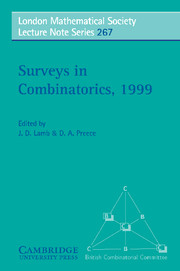The Coming of the Matroids
Published online by Cambridge University Press: 05 May 2013
Summary
Summary The author rehearses his role in the development of the theory of matroids. The story starts in 1935 when he became an undergraduate at Trinity College, Cambridge, and started to collaborate with Leonard Brooks, Cedric Smith and Arthur Stone. It continues through his war-time work with codes and ciphers, followed by his return to Trinity in 1945, where his PhD thesis entitled “An Algebraic Theory of Graphs” foreshadowed his matroid papers published in 1958 and 1959. He describes the context in which he obtained the now well-known excluded minor conditions for a binary matroid to be regular and for a regular matroid to be graphic. He subsequently invented the whirl, and lectured on matroids at the 1964 Conference where the theory of matroids was first proclaimed to the world. This paper has two appendices: “Geometrical Terminology” and “Binary and Regular Matroids”.
As we all know, matroids made their appearance in the mathematical literature in 1935, in a paper of Hassler Whitney entitled “On the abstract properties of linear dependence” [17].
Whitney looked at a matrix and saw that some sets of columns were independent and some were not. There were even simple rules about this distinction. For example, any subset of an independent set of columns is independent—provided of course that you count the null set as independent. Also, if you had an independent set A you could make it into a bigger one by adding the right member of any independent set that was bigger than A.
- Type
- Chapter
- Information
- Surveys in Combinatorics, 1999 , pp. 3 - 14Publisher: Cambridge University PressPrint publication year: 1999



